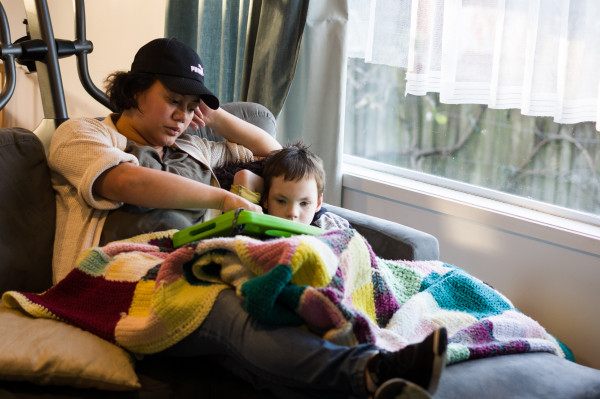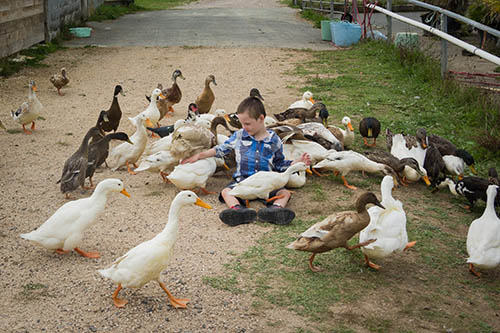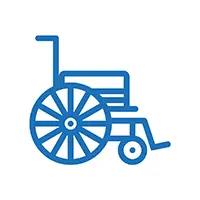Published 15 January 2019
When Julie Morris found out her three month-old son had cri-du-chat (pronounced cree-do-SHAA) syndrome, she had no idea what to expect.
It’s a rare genetic condition typified by the high-pitched cry of infants who have it.
That’s where its name comes from - it’s French for “cat-cry”, or “cry of the cat”.
Julie wasn’t as devastated as you might expect a parent to be when discovering their child has a genetic disorder.
Instead, she was relieved that it wasn’t a degenerative illness. This meant her boy, Thomas, would likely get better rather than worse.
“I’m good at not forming expectations.
“I kind of figured, this is my child, and no diagnosis is going to change him, it’s just going to describe what’s already here,” she says.
Now nearly six years-old, the past few years have brought huge challenges for Julie and her husband, Jordan.
They’ve juggled getting the right support for Thomas and managing his needs, while also raising two other children – Isla, who’s four-and-a-half, and Casper, who’s 18 months-old.
What is cri-du-chat syndrome?
In people with cri-du-chat, part of their fifth chromosome is missing.
Specifically, the small arm (otherwise called the p arm), of chromosome five. It’s sometimes called 5p minus syndrome.
That means a chunk of their genetic material has been deleted, resulting in delayed development, intellectual impairment and a high-pitched cry.
There are other symptoms as well, but they’re not the same for everybody who has it.
The symptoms depend on how much of the chromosome arm was deleted.
Most people who have cri-du-chat don’t have a history of it in their family, and it’s not usually inherited.
Cri-du-chat syndrome is relatively rare – about 1 in 20,000 to 50,000 babies are born with it.
That’s compared with about 1 in 1000 for Down Syndrome, a more common genetic disorder.

Thomas cools off during a visit to see his Grandad at Rawene in 2017.
The diagnosis
Late in Julie’s pregnancy, at full term, Thomas had stopped growing properly so he was induced. When he was born he weighed just 2.32kg.
He wasn’t formally diagnosed with anything right away.
By the time he was three months-old, Julie and Jordan felt things weren’t quite right with Thomas and they wanted some answers.
A paediatrician saw him and agreed that some things were unusual, and tests were ordered.
When the official diagnosis of cri-du-chat came in, Jordan struggled more than she did, Julie says.
She says she’s naturally adaptable, so she was able to cope relatively well.
But Jordan had a more “normal” reaction.
“I guess [for him] it was the fear of not being able to communicate properly with your child.
“You have these expectations coming into it that have now been shattered.”
It was a tough first year for the family, as Thomas struggled with sleeping and feeding.
Children with cri-du-chat often have coordination issues, and Thomas found feeding difficult.
They were also told early on that he would likely be intellectually impaired.
But Julie says they tried to keep an open mind about what Thomas’s life would look like.
“One thing the paediatrician told us was that there was a lot about cri-du-chat they still don’t know.
“They gave us the statistics and explained there’s a big range of symptoms, but the genetic science is still quite early so they’re still not entirely sure what it means,” she says.
Developing in his own time
Thomas is developing and learning to do things any other child will do, but it’s taking him a little longer.
Because of his poor muscle tone, Thomas had a hard time sitting by himself, but he got there at about 18 months old.
He can take a few steps by himself now, and he’s pretty good when using a walker.
Thomas doesn’t speak many words and he struggles to make the right sounds.
Julie says he’s managed to string a couple of words together, but he can’t speak in sentences yet.
But he has a programme called PODD for his iPad which enables him to communicate by tapping on pictures on the screen.

Thomas and his support worker having a chat about what they can see out the window using his high-tech PODD device.
Seeing the real Thomas
Julie sees Thomas as he is, and not just his disability.
Early on he showed a strong affinity to music, a trait Julie believes is “just him”, and not a symptom of cri-du-chat.
“He was born a drummer. He’s always had a strong passion for drumming and for music.
“He loves acapella singing. Even has a baby he loved deep voices and minor keys, which most babies are supposed to not like.”
There were times, Julie says, when Thomas would get overwhelmed during feeding and forget how to do it.
She put on Johnny Cash’s ‘Ring of Fire’ and suddenly he calmed down and started feeding again.
“He has a good sense of rhythm and he’s exploring notes on the xylophone, although I don’t recognise any of the tunes he’s played so far.
“He likes to sing, and quite often he’s the only one who knows what he’s singing but that’s OK.”
One personality trait Thomas has that’s typical of children with cri-du-chat is his love of water.
The importance of having good support
Thomas receives support for his disability, such as people who come to the family home to help take care of him.
Julie says there have been a range of support workers who’ve helped along the way, and the good ones have become like part of the family.
“I just can’t imagine doing any of this without them.
“There have been times when we haven’t had any support and it’s been really hard, and people say they don’t know how I do it, and I probably couldn’t if it was just me,” she says.
Thomas gets funding for some hours of support from Taikura Trust, which the family uses through Lifewise.
The funding scheme allows the family to find their own support workers and pay them, rather than being told who they must use.
Julie says that support enables them to go out and do things as a family.
“Thomas is quite tall now and he likes to pull himself up and see what he can reach, and it can be quite overwhelming keeping an eye on him as well as the two other children.
“But with an extra person around to support Thomas, we can do it.”
Julie says it took a considerable amount of effort to find the right support, but it was worth the trouble.
“When you’re overwhelmed and people say you should just get more help, finding the energy to actually be proactive and find someone is really difficult.
“But once you’re there it’s really good,” she says.

Thomas during a visit to a family friend's farm in Kerikeri, which has 90 ducks! Julie says: "We were so proud of Thomas, who handled the noise and clambering ducks beautifully! He has really come a long way in what he can handle."














